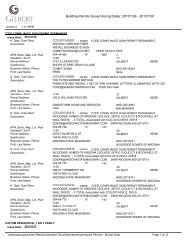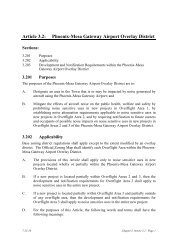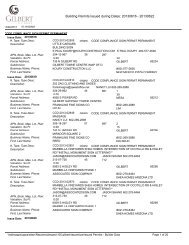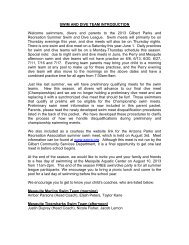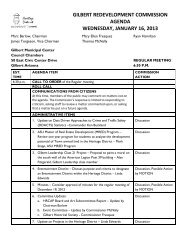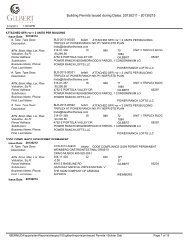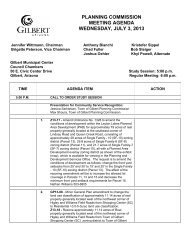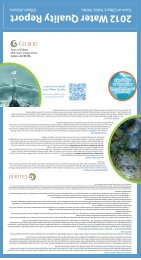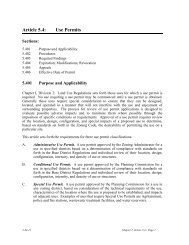V I S T A - Town of Gilbert
V I S T A - Town of Gilbert
V I S T A - Town of Gilbert
Create successful ePaper yourself
Turn your PDF publications into a flip-book with our unique Google optimized e-Paper software.
WATER<br />
The project includes a<br />
raw water intake on the<br />
RESOURCES<br />
Central Arizona Project<br />
(CAP) Canal, and a 14-mile 48” raw water pipeline.<br />
sized to handle the ultimate 48 mgd plant capacity.<br />
The CAP canal delivers<br />
Colorado River Water from the<br />
New Waddell Dam across the<br />
state to supply Arizona<br />
communities with a renewable<br />
resource for drinking water.<br />
The New Wadell Dam allows<br />
CAP to deliver up to 1.8 million<br />
acre-feet <strong>of</strong> Colorado River water per year into<br />
central and southern Arizona when the water is<br />
available. The canal is owned and operated by the<br />
CAWCD.The <strong>Town</strong> <strong>of</strong> <strong>Gilbert</strong> and the City <strong>of</strong> Chandler<br />
manage multiple water resources including surface<br />
water from the CAP system, the SRP system and<br />
groundwater supplies from wells to provide<br />
economical drinking water to their customers.<br />
The CAP surface water supply is integral to their<br />
water resources portfolio and the new Santan Vista<br />
WTP is designed to treat this CAP water supply to<br />
meet current and future potable water regulations.<br />
Central Arizona Project (CAP) System<br />
SANTAN VISTA WTP<br />
BY THE NUMBERS<br />
24 million<br />
Gallons <strong>of</strong> water the plant<br />
can treat per day -<br />
expandable to 48 million gallons<br />
10<br />
100,000+<br />
5 million<br />
10%<br />
Finished water pumps delivering water to<br />
<strong>Gilbert</strong> and Chandler customers<br />
Number <strong>of</strong> people the plant<br />
serves in both communities<br />
Gallons <strong>of</strong> water the reservoir<br />
can hold<br />
Amount <strong>of</strong> space needed compared to<br />
conventional treatment, the compact<br />
footprint <strong>of</strong> the ballasted flocculation process takes<br />
up a fraction <strong>of</strong> the area<br />
SANTAN<br />
V I S T A<br />
Water Treatment Plant<br />
A PARTNERSHIP<br />
Arizona’s vast<br />
landscape draws<br />
OF TWO CITIES<br />
thousands <strong>of</strong> new<br />
residents every year, and proper planning for this<br />
growth is essential for life in the desert.<br />
As evidenced by the delivery<br />
<strong>of</strong> the new Santan Vista Water<br />
Treatment Plant, which features<br />
an array <strong>of</strong> advanced technologies,<br />
the <strong>Town</strong> <strong>of</strong> <strong>Gilbert</strong> and City<br />
<strong>of</strong> Chandler are positioned to<br />
take on future opportunities. This<br />
jointly owned WTP will deliver<br />
the highest quality, state-<strong>of</strong>-the-art drinking water to<br />
over 100,000 people everyday in both communities.<br />
The two cities are among the fastest growing in the<br />
U.S. and their combined population has expanded to<br />
about 500,000 residents today.<br />
The two municipalities worked together for over a<br />
decade to plan the joint facility. Process technologies<br />
and delivery methods were evaluated for the new<br />
water treatment plant that would serve the area and<br />
meet the standards <strong>of</strong> prevailing and future anticipated<br />
drinking water regulations. The end result is the Santan<br />
Vista WTP, with an initial treatment capacity <strong>of</strong> 24<br />
million gallons per day (mgd), expandable to 48 mgd.<br />
The plant is located in the <strong>Town</strong> <strong>of</strong> <strong>Gilbert</strong> and operated<br />
by <strong>Gilbert</strong> water treatment plant pr<strong>of</strong>essionals.<br />
Existing<br />
<strong>Gilbert</strong><br />
WTP<br />
www.ci.gilbert.az.us<br />
www.chandleraz.gov<br />
Existing<br />
Chandler<br />
WTP<br />
www.cap-az.com<br />
3695 East Ocotillo Road • <strong>Gilbert</strong>, AZ 85298
THE SANTAN VISTA<br />
WATER TREATMENT PROCESS<br />
1<br />
Raw Water Intake,<br />
Metering and Control<br />
From the CAP canal, the water<br />
travels 14 miles and falls 200 feet<br />
in elevation.<br />
2 Ballasted<br />
Flocculation<br />
Rapidly removes particles by<br />
weighing them down with silica<br />
sand.<br />
3<br />
Ozone with<br />
Contact Basin<br />
Improves filterability and<br />
removes taste and odor.<br />
PUBLIC HEALTH<br />
The Center for Disease<br />
Control and Prevention<br />
PROTECTION and the National<br />
Academy <strong>of</strong> Engineers named water treatment as one<br />
<strong>of</strong> the most significant public health advances <strong>of</strong> the<br />
20th century. Advanced processes, such as Ballasted<br />
Flocculation and Ozone enhance public health by<br />
improving the barriers to pathogens while decreasing<br />
the level <strong>of</strong> suspected carcinogens in the water.<br />
As such, the Santan Vista WTP has a robust process<br />
design that employs multiple barriers for maximum<br />
operational flexibility and treatment <strong>of</strong> varying raw<br />
water qualities. The plant incorporates the latest in<br />
modern water treatment technology and automation.<br />
The plant is designed with quality systems and<br />
redundancy to protect the public health. The design<br />
team and operating staff collaborated with the<br />
Maricopa County Environmental Services<br />
Department to ensure the treatment process meets<br />
regulatory requirements. Water quality tests are run<br />
daily to ensure healthy, aesthetically pleasing (taste,<br />
odor, color) water is produced.<br />
ENVIRONMENTAL<br />
The Santan Vista<br />
WTP was designed<br />
STEWARDSHIP and constructed in<br />
a manner that was consistent with the <strong>Town</strong> <strong>of</strong><br />
<strong>Gilbert</strong>’s and City <strong>of</strong> Chandler’s focus on<br />
environmental management.<br />
State-<strong>of</strong>-the-art technology is used to generate a<br />
“bleach” solution on site for chlorination to reduce<br />
hazardous chemicals stored at the plant. Water is<br />
recovered from the residuals captured in the<br />
process and recycled into drinking water to<br />
conserve our precious resource in the desert.<br />
In addition, CAP water comes from a sustainable<br />
source <strong>of</strong> supply: surface water and snow melt<br />
into the Colorado River.<br />
By bringing this additional renewable water supply<br />
into the desert, the <strong>Town</strong> <strong>of</strong> <strong>Gilbert</strong> and City <strong>of</strong><br />
Chandler have helped to reduce groundwater<br />
dependence in the area and improve livability for<br />
residents <strong>of</strong> both communities.<br />
Only 1% <strong>of</strong> the water is<br />
wasted to evaporation<br />
during the treatment and<br />
washwater process.<br />
Over 99% <strong>of</strong> the raw water<br />
is recovered by the<br />
treatment process.<br />
Ten tons <strong>of</strong> sand are<br />
contained within the<br />
treatment process.<br />
Silica microsand has<br />
a diameter <strong>of</strong> about<br />
85 microns.<br />
23,074 cubic yards <strong>of</strong><br />
concrete and 265 tons <strong>of</strong><br />
structural steel were used<br />
in construction <strong>of</strong> the<br />
plant, as well as 195<br />
miles <strong>of</strong> electrical wire.<br />
4 Deep-Bed<br />
Monomedia Filtration<br />
Removes viruses, bacteria,<br />
and particulates as small as one<br />
micron<br />
5<br />
Reservoir and Finished<br />
Water Pumping Station<br />
Delivers fresh potable drinking<br />
water to the customers <strong>of</strong> both<br />
<strong>Gilbert</strong> and Chandler<br />
Construction led to a<br />
surprising discovery when<br />
workers found an upperforeleg<br />
bone <strong>of</strong> a large<br />
prehistoric camel known<br />
as a camelops. The fossil<br />
was turned over to the<br />
Arizona Museum <strong>of</strong><br />
Natural History, in Mesa,<br />
Arizona.<br />
6<br />
Recovered Water<br />
Water used to clean<br />
particles from the filters is<br />
separated and recycled<br />
Designer<br />
Construction Manager<br />
Black & Veatch<br />
Carollo Engineers<br />
Program Manager<br />
Arcadis<br />
Contractor<br />
Sundt




